How to use the seven sorting methods of Java data structures
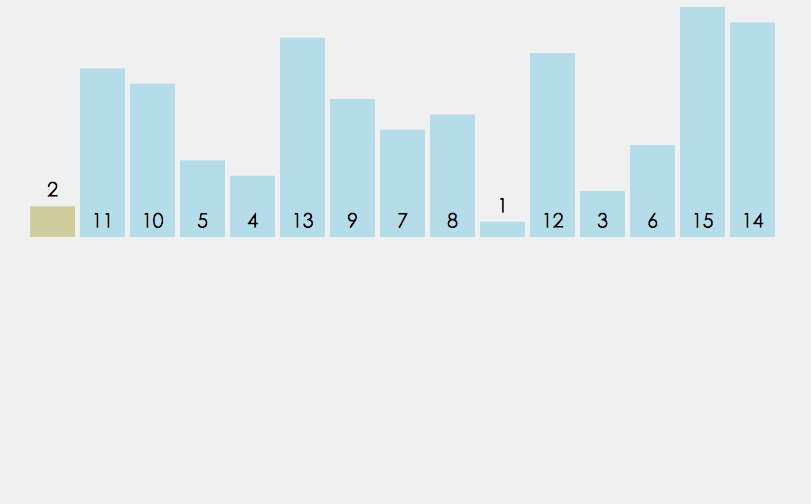
public static void insertSort(int[] array){
for (int i = 1; i < array.length; i++) {
int tmp=array[i];
int j=i-1;
for(;j>=0;--j){
if(array[j]>tmp){
array[j+1]=array[j];
}else{
break;
}
}
array[j+1]=tmp;
}
}- Hill sort is an optimization of direct insertion sort.
- The purpose is to make the array closer to order, so pre-sorting is performed when gap > 1. Insertion sort can quickly sort a nearly ordered array when the gap is 1.
- The time complexity of Hill sorting is difficult to calculate, because there are many ways to obtain gap values, making it difficult to calculate.
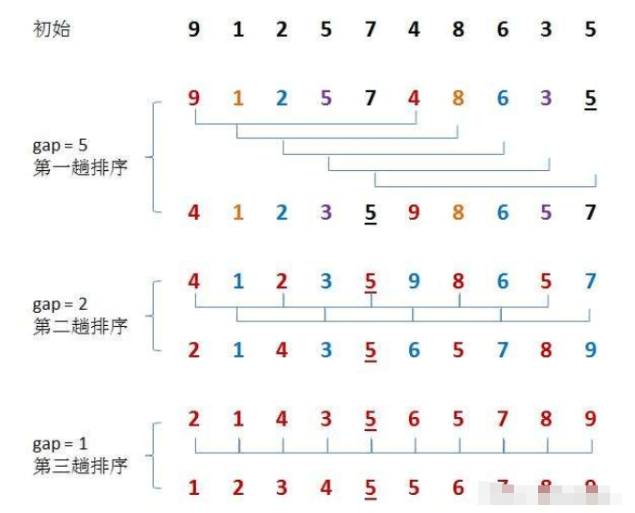
public static void shellSort(int[] array){
int size=array.length;
//这里定义gap的初始值为数组长度的一半
int gap=size/2;
while(gap>0){
//间隔为gap的直接插入排序
for (int i = gap; i < size; i++) {
int tmp=array[i];
int j=i-gap;
for(;j>=0;j-=gap){
if(array[j]>tmp){
array[j+gap]=array[j];
}else{
break;
}
}
array[j+gap]=tmp;
}
gap/=2;
}
}- Select the smallest data element in the element set array[i]--array[n-1]
- If it is not the first element in this set of elements one, then exchange it with the first element in this set of elements
- In the remaining set, repeat the above steps until there is 1 element left in the set
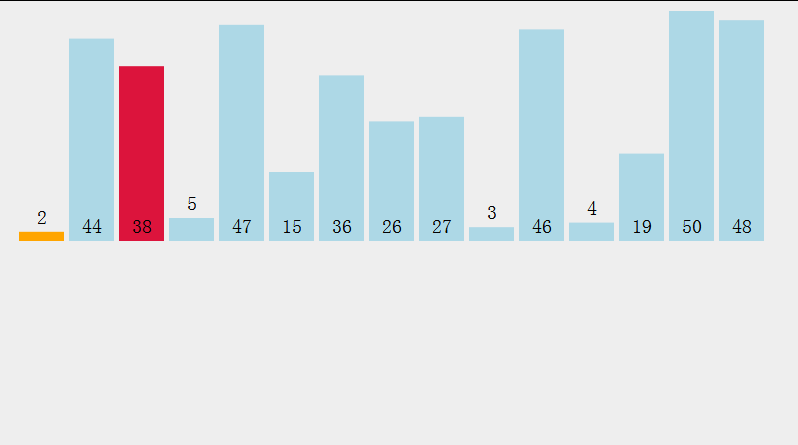
//交换
private static void swap(int[] array,int i,int j){
int tmp=array[i];
array[i]=array[j];
array[j]=tmp;
}
//选择排序
public static void chooseSort(int[] array){
for (int i = 0; i < array.length; i++) {
int minIndex=i;//记录最小值的下标
for (int j = i+1; j < array.length; j++) {
if (array[j]<array[minIndex]) {
minIndex=j;
}
}
swap(array,i,minIndex);
}
}- Create a small root heap, in order Take out the top element of the heap and put it into the array until the heap is empty
- Create a large root heap, define the tail element position key of the heap, and exchange the top element of the heap and the element at the key position each time (key --), until the key reaches the top of the heap. At this time, the sequential traversal of the elements in the heap is in ascending order (as follows)
Space complexity: O(N), unstableHeap sort:
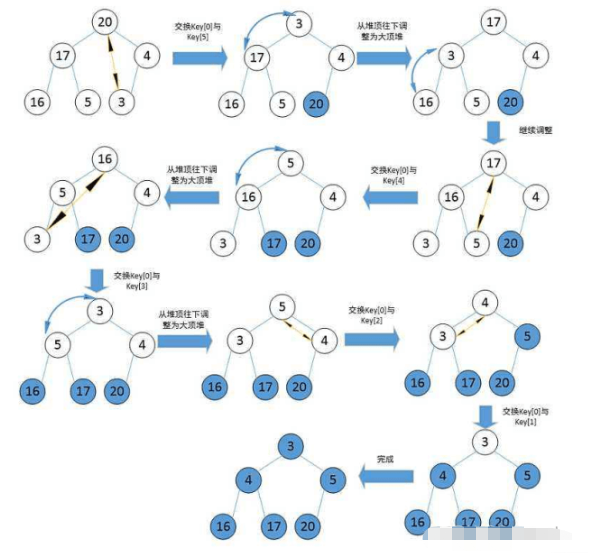
//向下调整
public static void shiftDown(int[] array,int parent,int len){
int child=parent*2+1;
while(child<len){
if(child+1<len){
if(array[child+1]>array[child]){
child++;
}
}
if(array[child]>array[parent]){
swap(array,child,parent);
parent=child;
child=parent*2+1;
}else{
break;
}
}
}
//创建大根堆
private static void createHeap(int[] array){
for (int parent = (array.length-1-1)/2; parent >=0; parent--) {
shiftDown(array,parent,array.length);
}
}
//堆排序
public static void heapSort(int[] array){
//创建大根堆
createHeap(array);
//排序
for (int i = array.length-1; i >0; i--) {
swap(array,0,i);
shiftDown(array,0,i);
}
}
public static void bubbleSort(int[] array){
for(int i=0;i<array.length-1;++i){
int count=0;
for (int j = 0; j < array.length-1-i; j++) {
if(array[j]>array[j+1]){
swap(array,j,j+1);
count++;
}
}
if(count==0){
break;
}
}
}public static void quickSort(int[] array,int left,int right){
if(left>=right){
return;
}
int l=left;
int r=right;
int tmp=array[l];
while(l<r){
while(array[r]>=tmp&&l<r){
//等号不能省略,如果省略,当序列中存在相同的值时,程序会死循环
r--;
}
array[l]=array[r];
while(array[l]<=tmp&&l<r){
l++;
}
array[r]=array[l];
}
array[l]=tmp;
quickSort(array,0,l-1);
quickSort(array,l+1,right);
} //key值的优化,只在快速排序中使用,则可以为private
private int threeMid(int[] array,int left,int right){
int mid=(left+right)/2;
if(array[left]>array[right]){
if(array[mid]>array[left]){
return left;
}
return array[mid]<array[right]?right:mid;
}else{
if(array[mid]<array[left]){
return left;
}
return array[mid]>array[right]?right:mid;
}
}随着我们递归的进行,区间会变的越来越小,我们可以在区间小到一个值的时候,对其进行插入排序,这样代码的效率会提高很多。
(3)快速排序的非递归实现
//找到一次划分的下标
public static int patition(int[] array,int left,int right){
int tmp=array[left];
while(left<right){
while(left<right&&array[right]>=tmp){
right--;
}
array[left]=array[right];
while(left<right&&array[left]<=tmp){
left++;
}
array[right]=array[left];
}
array[left]=tmp;
return left;
}
//快速排序的非递归
public static void quickSort2(int[] array){
Stack<Integer> stack=new Stack<>();
int left=0;
int right=array.length-1;
stack.push(left);
stack.push(right);
while(!stack.isEmpty()){
int r=stack.pop();
int l=stack.pop();
int p=patition(array,l,r);
if(p-1>l){
stack.push(l);
stack.push(p-1);
}
if(p+1<r){
stack.push(p+1);
stack.push(r);
}
}
}四、归并排序
归并排序(MERGE-SORT):该算法是采用分治法(Divide and Conquer)的一个非常典型的应用。实现序列的完全有序,需要将已经有序的子序列合并,即先让每个子序列有序,然后再将相邻的子序列段有序。若将两个有序表合并成一个有序表,称为二路归并。
时间复杂度:O(n*logN)(无论有序还是无序)
空间复杂度:O(N)。是稳定的排序。
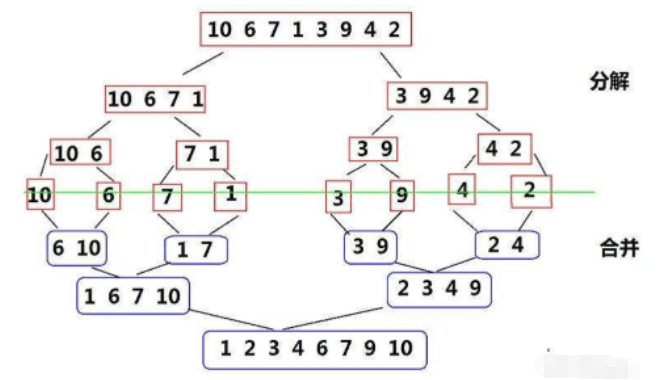
//归并排序:递归
public static void mergeSort(int[] array,int left,int right){
if(left>=right){
return;
}
int mid=(left+right)/2;
//递归分割
mergeSort(array,left,mid);
mergeSort(array,mid+1,right);
//合并
merge(array,left,right,mid);
}
//非递归
public static void mergeSort1(int[] array){
int gap=1;
while(gap<array.length){
for (int i = 0; i < array.length; i+=2*gap) {
int left=i;
int mid=left+gap-1;
if(mid>=array.length){
mid=array.length-1;
}
int right=left+2*gap-1;
if(right>=array.length){
right=array.length-1;
}
merge(array,left,right,mid);
}
gap=gap*2;
}
}
//合并:合并两个有序数组
public static void merge(int[] array,int left,int right,int mid){
int[] tmp=new int[right-left+1];
int k=0;
int s1=left;
int e1=mid;
int s2=mid+1;
int e2=right;
while(s1<=e1&&s2<=e2){
if(array[s1]<=array[s2]){
tmp[k++]=array[s1++];
}else{
tmp[k++]=array[s2++];
}
}
while(s1<=e1){
tmp[k++]=array[s1++];
}
while(s2<=e2){
tmp[k++]=array[s2++];
}
for (int i = left; i <= right; i++) {
array[i]=tmp[i-left];
}
}五、排序算法的分析
| 排序方法 | 最好时间复杂度 | 最坏时间复杂度 | 空间复杂度 | 稳定性 |
| 直接插入排序 | O(n) | O(n^2) | O(1) | 稳定 |
| 希尔排序 | O(n) | O(n^2) | O(1) | 不稳定 |
| 直接排序 | O(n^2) | O(n^2) | O(1) | 不稳定 |
| 堆排序 | O(nlog(2)n) | O(nlog(2)n) | O(1) | 不稳定 |
| 冒泡排序 | O(n) | O(n^2) | O(1) | 稳定 |
| 快速排序 | O(nlog(2)n) | O(n^2) | O(nlog(2)n) | 不稳定 |
| 归并排序 | O(nlog(2)n) | O(nlog(2)n) | O(n) | 稳定 |
The above is the detailed content of How to use the seven sorting methods of Java data structures. For more information, please follow other related articles on the PHP Chinese website!

Hot AI Tools

Undresser.AI Undress
AI-powered app for creating realistic nude photos

AI Clothes Remover
Online AI tool for removing clothes from photos.

Undress AI Tool
Undress images for free

Clothoff.io
AI clothes remover

Video Face Swap
Swap faces in any video effortlessly with our completely free AI face swap tool!

Hot Article

Hot Tools

Notepad++7.3.1
Easy-to-use and free code editor

SublimeText3 Chinese version
Chinese version, very easy to use

Zend Studio 13.0.1
Powerful PHP integrated development environment

Dreamweaver CS6
Visual web development tools

SublimeText3 Mac version
God-level code editing software (SublimeText3)

Hot Topics
 1664
1664
 14
14
 1423
1423
 52
52
 1317
1317
 25
25
 1268
1268
 29
29
 1242
1242
 24
24
 Break or return from Java 8 stream forEach?
Feb 07, 2025 pm 12:09 PM
Break or return from Java 8 stream forEach?
Feb 07, 2025 pm 12:09 PM
Java 8 introduces the Stream API, providing a powerful and expressive way to process data collections. However, a common question when using Stream is: How to break or return from a forEach operation? Traditional loops allow for early interruption or return, but Stream's forEach method does not directly support this method. This article will explain the reasons and explore alternative methods for implementing premature termination in Stream processing systems. Further reading: Java Stream API improvements Understand Stream forEach The forEach method is a terminal operation that performs one operation on each element in the Stream. Its design intention is
 PHP: A Key Language for Web Development
Apr 13, 2025 am 12:08 AM
PHP: A Key Language for Web Development
Apr 13, 2025 am 12:08 AM
PHP is a scripting language widely used on the server side, especially suitable for web development. 1.PHP can embed HTML, process HTTP requests and responses, and supports a variety of databases. 2.PHP is used to generate dynamic web content, process form data, access databases, etc., with strong community support and open source resources. 3. PHP is an interpreted language, and the execution process includes lexical analysis, grammatical analysis, compilation and execution. 4.PHP can be combined with MySQL for advanced applications such as user registration systems. 5. When debugging PHP, you can use functions such as error_reporting() and var_dump(). 6. Optimize PHP code to use caching mechanisms, optimize database queries and use built-in functions. 7
 PHP vs. Python: Understanding the Differences
Apr 11, 2025 am 12:15 AM
PHP vs. Python: Understanding the Differences
Apr 11, 2025 am 12:15 AM
PHP and Python each have their own advantages, and the choice should be based on project requirements. 1.PHP is suitable for web development, with simple syntax and high execution efficiency. 2. Python is suitable for data science and machine learning, with concise syntax and rich libraries.
 PHP vs. Other Languages: A Comparison
Apr 13, 2025 am 12:19 AM
PHP vs. Other Languages: A Comparison
Apr 13, 2025 am 12:19 AM
PHP is suitable for web development, especially in rapid development and processing dynamic content, but is not good at data science and enterprise-level applications. Compared with Python, PHP has more advantages in web development, but is not as good as Python in the field of data science; compared with Java, PHP performs worse in enterprise-level applications, but is more flexible in web development; compared with JavaScript, PHP is more concise in back-end development, but is not as good as JavaScript in front-end development.
 PHP vs. Python: Core Features and Functionality
Apr 13, 2025 am 12:16 AM
PHP vs. Python: Core Features and Functionality
Apr 13, 2025 am 12:16 AM
PHP and Python each have their own advantages and are suitable for different scenarios. 1.PHP is suitable for web development and provides built-in web servers and rich function libraries. 2. Python is suitable for data science and machine learning, with concise syntax and a powerful standard library. When choosing, it should be decided based on project requirements.
 Java Program to Find the Volume of Capsule
Feb 07, 2025 am 11:37 AM
Java Program to Find the Volume of Capsule
Feb 07, 2025 am 11:37 AM
Capsules are three-dimensional geometric figures, composed of a cylinder and a hemisphere at both ends. The volume of the capsule can be calculated by adding the volume of the cylinder and the volume of the hemisphere at both ends. This tutorial will discuss how to calculate the volume of a given capsule in Java using different methods. Capsule volume formula The formula for capsule volume is as follows: Capsule volume = Cylindrical volume Volume Two hemisphere volume in, r: The radius of the hemisphere. h: The height of the cylinder (excluding the hemisphere). Example 1 enter Radius = 5 units Height = 10 units Output Volume = 1570.8 cubic units explain Calculate volume using formula: Volume = π × r2 × h (4
 PHP's Impact: Web Development and Beyond
Apr 18, 2025 am 12:10 AM
PHP's Impact: Web Development and Beyond
Apr 18, 2025 am 12:10 AM
PHPhassignificantlyimpactedwebdevelopmentandextendsbeyondit.1)ItpowersmajorplatformslikeWordPressandexcelsindatabaseinteractions.2)PHP'sadaptabilityallowsittoscaleforlargeapplicationsusingframeworkslikeLaravel.3)Beyondweb,PHPisusedincommand-linescrip
 PHP: The Foundation of Many Websites
Apr 13, 2025 am 12:07 AM
PHP: The Foundation of Many Websites
Apr 13, 2025 am 12:07 AM
The reasons why PHP is the preferred technology stack for many websites include its ease of use, strong community support, and widespread use. 1) Easy to learn and use, suitable for beginners. 2) Have a huge developer community and rich resources. 3) Widely used in WordPress, Drupal and other platforms. 4) Integrate tightly with web servers to simplify development deployment.




